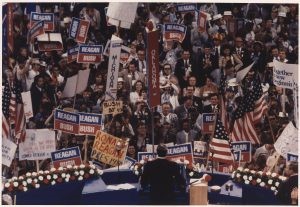Electoral College Myth #3: The Electoral College is undemocratic
by Tara Ross September 13, 2016
Myth number 3 in my series on Electoral College Myths! Please don’t miss the earlier installments here:
Myth #1: Only swing states matter, other states are ignored
Myth #2: The Founders did not trust the people
Myth: The person who wins the national popular vote should win the White House. The Electoral College does not guarantee such results and is thus undemocratic.
Fact: The question is not “democracy” v. “no democracy.” The question is “democracy with federalism” (the Electoral College) v. “democracy without federalism” (a direct popular vote).
What is federalism? Federalism is a reference to the fact that power in this country is divided between a single, national government and the state governments. The Constitution gives our national government in D.C. power in certain areas. All other power is left to the states or to the people themselves. In the context of presidential elections, the states are the driving factor behind the selection of electors and the Electoral College vote. We don’t hold one single, national election for President. As the system operates today, we hold many separate elections, one in each state.
Think about it. Are we really kicking democracy entirely out of the process? In this country, Americans participate in 51 purely democratic elections each and every presidential election year—one in each state and one in D.C. This first phase of the election is what you think of as “Election Day.” These purely democratic, state-level elections determine which individuals (electors) will represent their states in a second phase of the election. Part Two of the election occurs in December—with much less media fanfare!—and is a federalist election among the states. There are 538 electors who participate in this election. A majority of them (270) can elect a President.
America’s unique blend of democracy and federalism has served the country well because it encourages presidential candidates to create national coalitions. A candidate must do more than simply rack up a majority of voters in one region or among the voters of one special interest group. He must appeal to a variety of Americans before he can win 270 states’ electoral votes. A direct popular election would not create the same set of incentives. Instead, the candidate who obtains the most individual votes—even if they are obtained exclusively in one region or in a handful of urban areas—would be able to win the presidency.
This year’s election has been a bit problematic, at least in part, because our political primaries veer from the healthy incentives that I’ve just described. Whereas the Electoral College encourages coalition-building, the primaries encouraged divisiveness. And while the Electoral College requires candidates to win the support of a majority of states’ electors, the primaries did not require a majority of anything. Instead, bare pluralities were sufficient for victory.
Is it any wonder that we’ve been less and less satisfied with the results of our political primaries as they become more purely democratic over time? Is it any wonder that both Donald Trump and Hillary Clinton are having trouble building coalitions now?
America is a large and diverse country, composed of both large and small states. It deserves a unique election process, ensuring that all voices are heard in the election of its President. The Electoral College, with its combination of democracy and federalism, has served the country well in this regard for more than 200 years. Perhaps the political parties could learn a thing or two when they consider how to change their political nomination processes in 2020.
Please don’t miss my new kids’ illustrated book about the Electoral College!
Signed copies available at the bottom of THIS PAGE.
If you have Amazon Prime, shipping will be much cheaper with (unsigned) copies HERE.
This entry was posted in Electoral College resources. Bookmark the permalink.

